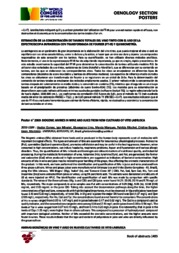Biogenic amines in wine and juice from new cultivars of vitis labrusca.
Biogenic amines in wine and juice from new cultivars of vitis labrusca.
Author(s): GOMEZ, H.; MINATEL, I.; LIMA, G.; MARQUES. M.; RITSCHEL, P. S.; BORGES, C.; MONTEIRO, G.
Summary: The biogenic amines (BAs) obtained from foods and/or produced in the human body represents a set of molecules with important biological effects. The types and amount of BAs are essential for innumerous physiological processes. Putrescine (Put), spermidine (Spd) and spermine (Spm), promotes cell division and may be useful in the healing process. However, when consumed in high concentrations, can induce headache, respiratory problems, hyper- and hypotension and various allergic disorders. Thus, the quantification of BAs in foods and beverages are relevant markers of nutritional quality, and industrial processing. During the malolactic fermentation of wine, histamine (His), tyramine (Tym), and Put, are generated; the former and cadaverine (Cad) when produced in high concentrations are suggested as indicators of bacterial contamination.
Publication year: 2016
Types of publication: Abstract in annals or event proceedings
Unit: Embrapa Grape & Wine
Keywords: Aminas biogênicas (BAs), Biogenic amines, Biological effects, Suco, Uva, Vitis labrusca
Observation
Some of Embrapa's publications are published as ePub files. To read them, use or download one of the following free software options to your computer or mobile device. Android: Google Play Books; IOS: iBooks; Windows and Linux: Calibre.
Access other publications
Access the Agricultural Research Database (BDPA) to consult Embrapa's full library collection and records.
Visit Embrapa Bookstore to purchase books and other publications sold by Embrapa.

